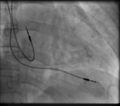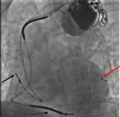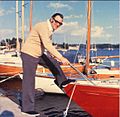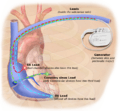Artificial pacemaker facts for kids
A pacemaker is a small electronic device. It helps your heart beat at a steady and healthy rhythm. If your heart beats too fast, the pacemaker can slow it down. If it beats too slowly, the pacemaker can speed it up. It uses gentle electrical pulses to do this. The first fully implantable pacemaker was created by Earl Bakken.
Contents
What is a Pacemaker and How Does it Work?
A pacemaker is a special device that helps control your heart's rhythm. Your heart has its own natural electrical system. This system tells your heart muscles when to squeeze and pump blood. Sometimes, this natural system doesn't work right. This can make your heart beat too slowly, too fast, or irregularly.
How Pacemakers Send Signals
A pacemaker fixes this problem by sending small electrical signals. These signals act like a tiny spark. They tell your heart when to beat. The device has a battery and a tiny computer. It also has wires, called leads. These leads connect the pacemaker to your heart.
Parts of a Pacemaker
- Pulse Generator: This is the main part of the pacemaker. It's a small metal box. It contains the battery and the computer circuits. This part creates the electrical pulses.
- Leads (Wires): These are thin, insulated wires. They connect the pulse generator to your heart. They carry the electrical signals to your heart. They also send information about your heart's natural rhythm back to the pacemaker.
Why Do People Need Pacemakers?
People need pacemakers for different reasons. All of them relate to problems with the heart's electrical system.
Common Heart Rhythm Problems
- Bradycardia: This means your heart beats too slowly. A slow heartbeat might not pump enough blood. This can make you feel tired or dizzy.
- Tachycardia: This means your heart beats too fast. Some pacemakers can help slow down a very fast heart rate.
- Heart Block: This happens when the electrical signals don't travel properly. They might be blocked or delayed. This causes the heart to beat irregularly.
Symptoms of Heart Rhythm Problems
If your heart isn't beating correctly, you might feel certain symptoms. These can include:
- Feeling very tired or weak
- Dizziness or lightheadedness
- Fainting spells
- Shortness of breath
- Chest pain
If a doctor finds that your heart's rhythm is a problem, they might suggest a pacemaker. The pacemaker helps your heart keep a steady, healthy beat. This makes sure your body gets enough blood and oxygen.
Getting a Pacemaker
Implanting a pacemaker is a common medical procedure. It is usually done by a heart doctor called a cardiologist.
The Procedure
The doctor makes a small cut, usually near your shoulder. They create a small pocket under the skin. This is where the pulse generator goes. Then, they guide the leads through a blood vessel. They place the tips of the leads inside your heart. X-rays help the doctor see where the leads are going. Once the leads are in place, they are connected to the pulse generator. The cut is then closed.
After the Procedure
After getting a pacemaker, most people can go back to their normal activities. The pacemaker works silently inside their body. Doctors regularly check the pacemaker. They use special devices to make sure it's working correctly. The battery in a pacemaker can last for many years. When it gets low, the pulse generator is replaced.
The History of Pacemakers
The idea of using electricity to help the heart is not new. Scientists and doctors worked for many years to create a safe and effective device.
Early Developments
- In the 1930s, doctors experimented with external devices. These machines were large and stayed outside the body.
- In 1958, the first fully implantable pacemaker was put into a person. This was a huge step forward. The patient was Arne Larsson from Sweden. He lived for many more years thanks to the pacemaker. He had 26 different pacemakers during his life.
Modern Pacemakers
Today's pacemakers are much smaller and more advanced. They can adjust to your activity level. For example, if you are exercising, the pacemaker can tell and speed up your heart rate. If you are resting, it will slow it down. This makes them very helpful for people living active lives.
Images for kids
See Also
 In Spanish: Marcapasos cardíaco artificial para niños
In Spanish: Marcapasos cardíaco artificial para niños












